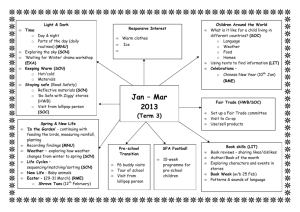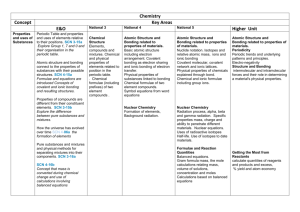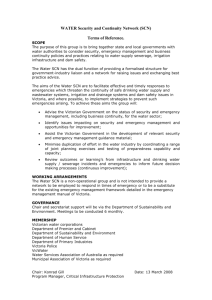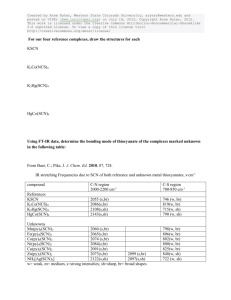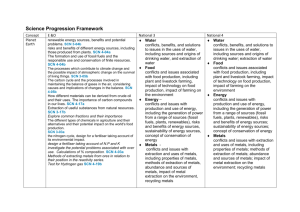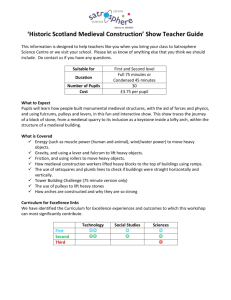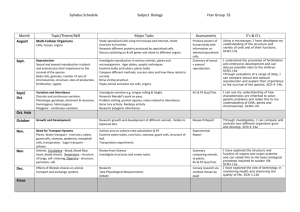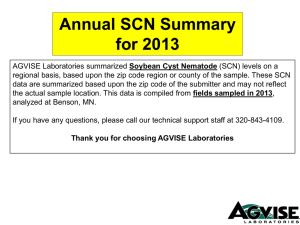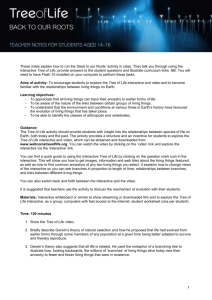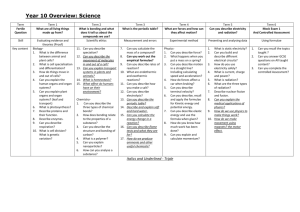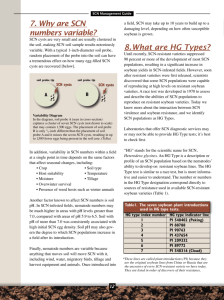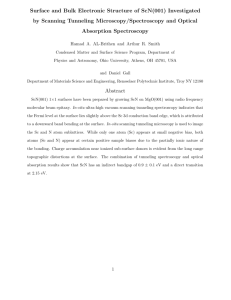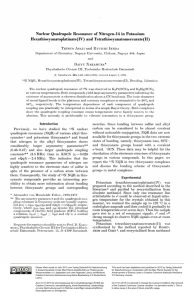Chemistry Concept Third and Fourth Level E&Os National 4
advertisement
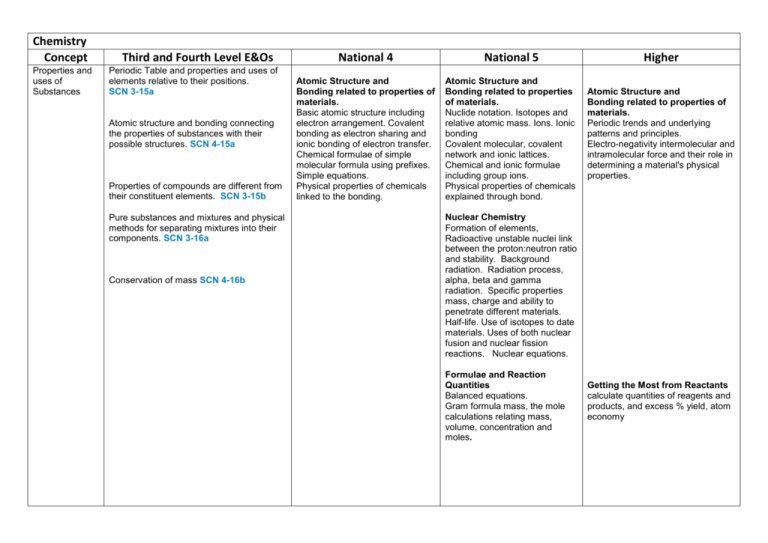
Chemistry Concept Properties and uses of Substances Third and Fourth Level E&Os Periodic Table and properties and uses of elements relative to their positions. SCN 3-15a Atomic structure and bonding connecting the properties of substances with their possible structures. SCN 4-15a Properties of compounds are different from their constituent elements. SCN 3-15b Pure substances and mixtures and physical methods for separating mixtures into their components. SCN 3-16a Conservation of mass SCN 4-16b National 4 National 5 Atomic Structure and Bonding related to properties of materials. Basic atomic structure including electron arrangement. Covalent bonding as electron sharing and ionic bonding of electron transfer. Chemical formulae of simple molecular formula using prefixes. Simple equations. Physical properties of chemicals linked to the bonding. Atomic Structure and Bonding related to properties of materials. Nuclide notation. Isotopes and relative atomic mass. Ions. Ionic bonding Covalent molecular, covalent network and ionic lattices. Chemical and ionic formulae including group ions. Physical properties of chemicals explained through bond. Higher Atomic Structure and Bonding related to properties of materials. Periodic trends and underlying patterns and principles. Electro-negativity intermolecular and intramolecular force and their role in determining a material's physical properties. Nuclear Chemistry Formation of elements, Radioactive unstable nuclei link between the proton:neutron ratio and stability. Background radiation. Radiation process, alpha, beta and gamma radiation. Specific properties mass, charge and ability to penetrate different materials. Half-life. Use of isotopes to date materials. Uses of both nuclear fusion and nuclear fission reactions. Nuclear equations. Formulae and Reaction Quantities Balanced equations. Gram formula mass, the mole calculations relating mass, volume, concentration and moles. Getting the Most from Reactants calculate quantities of reagents and products, and excess % yield, atom economy Earth’s Materials Society's energy needs, the risks and benefits of different energy sources, including those produced from plants. SCN 4-04a Formation and use of fossil fuels and responsible use and conservation of finite resources. SCN 4-04b Materials derived from crude oil and their uses. The importance of carbon compounds in our lives. SCN 4-17a Extraction of useful substances from natural resources. SCN 3-17b Nitrogen cycle. Design, composition, use and environmental impact of fertilisers. SCN 4-03a Fossil Fuels Formation and extraction processes for crude oil. The study of straight chained :alkanes alkenes To include their physical, chemical properties, general formulae, structural formulae and uses. Unsaturated and saturated hydrocarbons Chemical Reactions The use of fuels and their environmental impact on the carbon cycle Alternative energy source including biomass Homologous Series The study of straight and branched chained :Cycloalkanes Alkanols , Alkanoic Acids Esters To include their physical, chemical properties, general formulae, systematic names, structural formulae and uses. Isomers Chemical reactions addition, hydrolysis and condensation reactions Energy from Fuels Energy calculations involving ∆E = CM∆T Calculations based on balanced equations. Structure of organic compounds and their chemical properties Alkonols- primary, secondary tertiary Reactions of Alkonols Reactions of carboxylic acids Chemistry of Foods Fats and oils Proteins Flavourings Emulsions in Food Aldehydes Ketones Antioxidants Everyday consumer products. Soaps Everyday consumer products. Detergents/liquid soaps Fragrances including terpenes Essential oils Skincare Plants to products Practical based activity on products derived from plants which have enhanced everyday life. Rates of Reaction Reactions monitored and graphs interpreted. Rates of Reaction Average rate of reaction calculated from graph Controlling Reactions Collision theory Reaction profiles, Kinetic Energy Catalysts Acids and Bases Acids and Bases. Everyday consumer products. Alcoholic drinks sources and production Units in drinks and issues Analysis of carbohydrates. Benedict’s and iodine solutions. Solubility of carbohydrates Competing demands for carbohydrates as food or fuel Materials and Chemical Changes Indicators of chemical reactions. Controlling the rate of reactions. SCN 3-19a Properties of acids and bases. pH – measuring, adjusting and significance of pH in everyday life. SCN 3-18a Simple chemical cells and the factors which affect the voltage produced. SCN 3-10a Position of metals in the electrochemical series and their use in chemical cells. SCN 4-10a The latest developments in chemical cells technology and their impact on society. SCN 4-10b Novel materials and the scientific basis of their properties and the impacts on society. SCN 4-16a The effect of soluble oxides on the pH of water. Soluble oxides and their environmental impact. Uses of acids in food and drink and their impact on health. Selection of chemicals for salt formation The properties of Metals and Alloys Determination of the reactivity series using reactions of metals. Corrosion, physical and chemical protection of metals. Electrochemical Series and electrochemical cells. Voltage and electroplating Extraction of metals related to their reactivity. Displacement reactions. Composition, uses and physical properties of alloys. The properties of materials Metals in an order of reactivity and their everyday uses. SCN 4-19b Polymers, monomers, name of polymers, thermosoftening and thermosetting plastics, properties, uses and combustion of plastics, biodegrade plastics Advantages and disadvantages of natural versus synthetic polymers. Dissociation of water into hydrogen and hydroxide ions. pH is related to the concentration of hydrogen and hydroxide ions in pure water, acids and alkalis. Definitions of strong and weak based on degree of dissociation and related chemical properties. Acid/alkalis titration. Metals - Metallic bonding and resulting electrical conductivity Balanced ionic equations for reactions of metals, extraction of metals and reduction reactions. Reducing agents. Electrochemical cells including a non -metal electrode. Reactions of metals - electron flow, redox reactions, oxidation, reduction, Fuel cells and rechargeable batteries Properties of Plastics Addition and condensation polymerisation including Polythene, polyesters and polyamides. Representation of the structure of monomers and polymers, Natural polymers. Products of burning plastics Oxidising and Reducing Agents Elements, molecules and group ions as oxidising and reducing agents Ion electron redox equations Everyday uses of strong oxidising agents Getting the Most from Reactants Factors influencing the design of industrial process including cost availability of reactants and the environmental issues Ceramic materials properties and uses Materials – development of new materials, unique properties. reuse and recycle materials Energy changes in chemical reactions. SCN 4-19a Energy Changes of Chemical Reactions Energy Changes of Chemical Reactions Chemical Energy Enthalpy Recognising and uses of exothermic and endothermic reactions, Agrochemicals Plant nutrients, and elements, natural and synthetic fertiliser Chemical Analysis Qualitative analysis of the environment Overall energy changes from bond breaking and making. Hess’s law Bond Enthalpies Agrochemicals The Haber process to produce ammonia. Commercial production of nitrate fertilisers. Percentage mass compositions of fertilisers. Equilibria Reversible reactions dynamic equilibria, Chemical Analysis Techniques for monitoring the environment and methods for reducing pollution, titration with calculations. Chemical Analysis Chromatography Volumetric Titrations . Research Unit Research the chemistry underlying a given topical issue using a number of sources. Plan and carry out practical work, using common apparatus and techniques, to investigate an aspect of the topic. Prepare a scientific communication stating the aim, results and conclusions.
